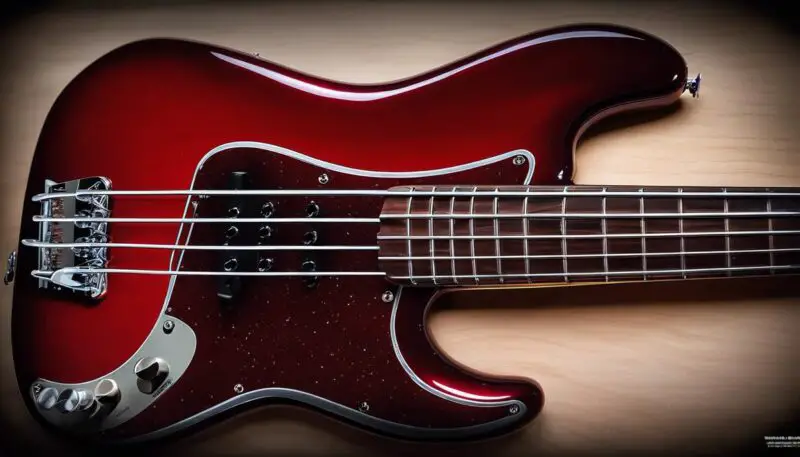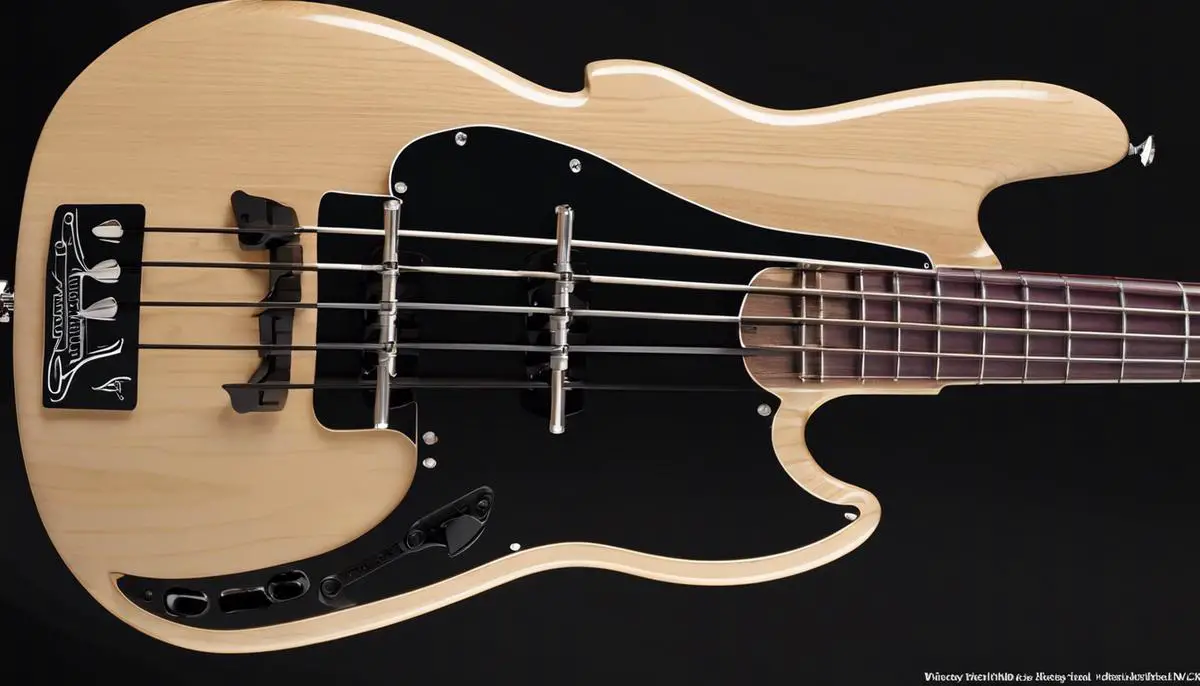Precision Bass String Replacement. Playing the Precision Bass, an iconic instrument cherished by many music enthusiasts, involves more than finely tuned movements of your fingers across strings. It’s about resonating with your instrument, understanding its anatomy, and maintaining its timbre and resonance.
From its intriguing structure and intricate parts to the bass bridge’s complex workings, there is an entire universe to explore. As an integral part of this exploration, this guide will highlight the role and importance of correctly choosing and replacing bass strings. You’ll come to appreciate how different materials and gauges affect the instrument’s sound and how you can achieve optimal performance through the meticulous process of string replacement.
Table of Contents
Understanding the Structure of a Precision Bass
The Precision Bass, affectionally known as the “P Bass,” was the first electric bass to earn widespread recognition and use, a creation of the musical genius Leo Fender in the early 1950s. This groundbreaking invention opened up new vistas in sound and performance, with the Precision Bass becoming the standard by which all other electric basses are judged.
The P-Bass presents a unique and sophisticated layout, with every component meticulously designed for maximum performance without compromising comfort. Let’s explore the layout and components of this class-beating bass guitar.
The P Bass Layout: Shape and Construction
The body shape of the P Bass is synonymous with comfort, convenience, and style. Typically, it boasts a double-cutaway body made from alder, though Fender does produce variations that use other types of tonewood, such as ash, poplar, and basswood. It’s also not uncommon to find models with bodies of high-end woods like mahogany or walnut, especially in higher-end models and signature series.
The double-cutaway design provides easy access to the higher frets on the neck. At the same time, its overall body shape contributes to a balanced weight distribution, ensuring that the bass sits comfortably, whether standing or sitting.
The Neck and Fingerboard
The P Bass typically has a one-piece maple neck with a uniform, thick, and comfortable “C” shape. The fretboard can vary between rosewood and maple, but higher-end models might feature pao ferro or ebony. The choice of fretboard wood does not merely contribute to the aesthetic. Still, each wood type delivers a different feel and tonal character, allowing players to match their instruments to their playing preferences and style.
Over the years, Fender has introduced neck profiles other than the traditional “C” shape, for example, the thinner “U” or “Modern C” profiles, offering players a more comprehensive range of choices.
Pickups and Electronics
At the heart of the P Bass sound lie the pickups and electronics. The original design boasts split single-coil pickups that deliver rich and warm tones, providing that signature P-Bass punch and grind that we’ve all come to love.
On the control aspect, the typical Precision Bass hosts a straightforward arrangement with a master volume and a master tone control, staying true to its “precision” name. It offers players an easy-to-master, no-fuss control scheme that’s practical and intuitive.
Hardware
Complementing the overall ensemble is the hardware, which includes the bridge, tuning machines, pickguard, and control knobs. The bridge on a P Bass traditionally features four adjustable saddles, allowing for precise intonation and action adjustment. The tuning machines usually are open-gear style, ensuring smooth, accurate tuning while adding to the cool vintage looks.
The pickguard usually has a single-layer or 3-ply design in various colors, contributing to the overall aesthetic appeal. The control knobs, in keeping with the vintage theme, typically have a knurled flat-top design.
Concluding Thoughts
A thorough understanding of the layout and components of a P Bass can significantly enhance a player’s appreciation for the instrument and performance capabilities. Whether a seasoned professional or a beginner, knowing what makes the Precision Bass tick goes a long way in getting the best out of this iconic bass guitar. Enjoy the play!

The Correct Bass Strings
Selecting the Right Strings for Your Precision Bass: A Comprehensive Guide
Diving deep into the world of Precision Bass, we’ve discussed everything from its birth in the electric bass landscape to the fine-tuned components that influence its iconic sound. But the strings are another vital aspect that plays a significant role in shaping your tone and playability. Understanding how to choose the proper set of strings can take your P Bass prowess to a whole new level.
P Bass strings come in several varieties – roundwound, flatwound, and half-round. The winding style affects the sound and feel of the strings and your playing style, so it’s crucial to make an informed decision.
Roundwound strings, with their ridged texture, are known to give a bright, punchy tone. They allow more treble, perfect for those looking for a crisp, clear sound. Their textured exterior, while enhancing sustain, might be a bit rougher to the feel, potentially causing finger noise.
Flatwound strings, however, are smooth to the touch and produce a darker, more mellow tone. They offer less sustain, but in the same vein, they also reduce finger noise. These strings are preferred by players looking for a more vintage or jazz-inspired sound.
Half rounds blend the two types above, having a smoother surface and delivering a tone somewhere between the bright sound of roundwounds and the mellowness of flatwounds.
Choosing the Right Strings for Your Bass Guitar
Another factor to consider is the string gauge. Gauge refers to the string’s thickness and directly influences the string’s tension and tonal quality. A light gauge (e.g., .040-.095) creates less tension, making it easier to fret the notes or bend the strings. Conversely, a heavy gauge (e.g., .050-.105) creates tension and offers more resistance but delivers a fuller, richer tone.
The type of material used to make the strings also makes a difference in sound quality. Nickel-plated steel is known for its balanced, all-around sound with ample brightness and sustaining power. On the other hand, pure nickel has a warmer, smoother tone, ideal for those pursuing vintage tones. For a brighter, more contemporary tone, stainless steel strings are the way to go.
Last but not least, while it might seem all strings are born equal, the brand and quality indeed matter. Top-tier brands consistently offer high quality and reliable performance, justified by slightly higher prices. Investing in good-quality strings to ensure longevity and optimal sound output is always a good idea.
Selecting the right strings for your P Bass isn’t merely a matter of taste; it requires a deep understanding of how each factor can contribute to creating your desired sound. Your playing style, the genre of music, and even how often you play can influence your choice of strings. Experimentation is vital – switch things up until you find the perfect match!

Bass String Replacement Process
Precision Bass String Replacement. The Sound of Different Strings on a Precision Bass
With the knowledge of the Precision Bass and its various components, the next big adventure is string replacement for those incomparable P-Bass vibes. One of the catalysts of the classic P Bass sound is the choice of strings. The right type can enhance your performance and bring out the warmth and punchiness that the Precision Bass is well-known for.
So, what are the types of strings available for a Precision Bass? Well, three common types are roundwound, flatwound, and half-round, each with its voice and feel on a P Bass.
Roundwound strings are easily recognized with ridges from winding wire around the core. These are the most common strings for a bass guitar, characterized by their brighter tone and articulate sound. However, with great tone comes a slightly stiffer feel under the fingertips because of the windings.
On the flip side, flatwound strings are constructed with a smooth surface. These strings are the go-to when aiming for that vintage bass sound—think Motown and old-school jazz. The flatwound strings cater for warm, mellow, and less sustain-intensive sound, accompanied by a smooth feel under your fingers. They are less noisy but prepare for a little more tension and a slightly higher price tag than roundwounds.
Half-round strings offer a happy medium between round wound and flatwound. Akin to roundwounds, the outer wire is ground down, resulting in a semi-smooth feel. If you want less finger noise without compromising much on the brightness, half-round strings are an excellent pick.
Strings come in variant gauges, which measure the string’s thickness. Lighter gauges (such as a .095 on a 4-string bass) deliver less tension, more effortless playability, and bright, rich tones, while heavier gauges (a .110 or higher) provide more volume, increased sustain and yield a more profound, robust tone.
String materials also impact the overall sound of a Precision Bass. Nickel-plated steel strings are most common, offering a balanced, classic tone that’s bright but not too harsh. Pure nickel strings deliver a warmer, more vintage tone, and stainless steel strings give a brilliantly bright, crisp tone and smooth feel.
Brand quality also matters when talking about your strings’ longevity, durability, and overall build. Many reputable brands in the market excel in producing high-quality strings for Precision Bass.
There’s no one-size-fits-all here; the type, gauge, and material of the string vary greatly depending on the player’s preference, playing style, genre of music, and frequency of use. A player aiming for a modern rock tone might lean towards round-wound strings with a higher gauge, while a jazz player might favor flatwound strings for that warm tone.
The world of Precision Bass strings is vast, dynamic, and personal. Embrace the journey because it’s all part of the experience. Experiment with different strings to find what resonates with you and defines your sound. Remember, the ultimate tone is subject to your liking, but with each tweak and change, the bass becomes even more a part of you. Harness these insights to guide your path to that perfect P Bass sound.

Mastery of the Precision Bass involves understanding its in-depth structure, selecting the correct strings, and delving into the nuanced process of string replacement. This knowledge is essential in enhancing the sound output, maintaining the ininstrument’songevity, and refining your finesse. Equipped with these insights, becoming an adept bass player becomes more enriching. Ultimately, the Precision Bass is not just an instrument but an extension of your creativity and musical exploration. Continue your journey with this newfound knowledge, and let every strum resonate with passion and precision.


